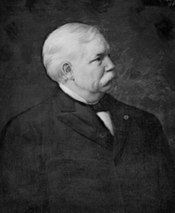| 56th United States Congress | |
|---|---|
55th ← → 57th | |
 United States Capitol (1906) | |
March 4, 1899 – March 4, 1901 | |
| Members | 90 senators 357 representatives 4 non-voting delegates |
| Senate majority | Republican |
| Senate President | Garret Hobart (R) (until November 21, 1899) Vacant (from November 21, 1899) |
| House majority | Republican |
| House Speaker | David B. Henderson (R) |
| Sessions | |
| 1st: December 4, 1899 – June 7, 1900 2nd: December 3, 1900 – March 3, 1901 | |
The 56th United States Congress was a meeting of the legislative branch of the United States federal government, composed of the United States Senate and the United States House of Representatives. It met in Washington, D.C., from March 4, 1899, to March 4, 1901, during the third and fourth years of William McKinley's presidency. The apportionment of seats in this House of Representatives was based on the 1890 United States census. Both chambers had a Republican majority. There was one African-American member, George Henry White of North Carolina, who served his second and final term as a representative in this Congress, and would be the last black member of Congress until 1928, and the last black member of Congress from the South until 1972.
Contents
- Major events
- Major legislation
- Territory organized
- Party summary
- Senate
- House of Representatives
- Leadership
- Senate 2
- House of Representatives 2
- Members
- Senate 3
- House of Representatives 3
- Changes in membership
- Senate 4
- House of Representatives 4
- Committees
- Senate 5
- House of Representatives 5
- Joint committees
- Caucuses
- Employees
- Legislative branch agency directors
- Senate 6
- House of Representatives 6
- See also
- References
- External links




